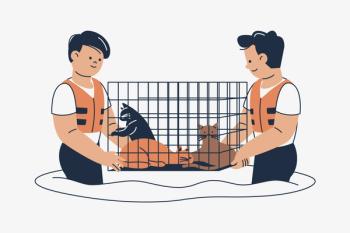
In case of emergency: Helping people escape with their pets
Help clients understand why and how they should put together a "Go bag" for their pet to be ready for emergency situations, like hurricanes, wildfires or tornadoes.
Shutterstock.comSome natural disasters, such as tornadoes, strike on a moment's notice. Others, like hurricanes, offer a few days' heads-up.
When evacuation is a necessity, having basic supplies on hand for pets is a big part of making a stressful period go smoother and ensures that the pet has exactly what it needs for those first few days. But chances are, most of your veterinary clients don't have these supplies together for themselves, much less for their pets. Help them be prepared by teaching them how to put together a "go bag" for their pet.
According to
> Food-at least three days' worth in an airtight, waterproof container
> Water-at least three days of water, in addition to the amount of water packed for human family members
> Medications and medical records
> Important paperwork pertaining to the pet-this includes registration information if that state requires a pet to be registered or licensed, adoption records, vaccination records and microchip information. The address associated with the microchip should be up to date.
> First aid supplies-basic supplies include cotton bandage rolls, bandage tape and scissors, antibiotic ointment, flea and tick preventives, latex gloves, isopropyl alcohol and saline solution.
> A collar or harness with ID, rabies tag and leash
> A crate or pet carrier-owners should have a sturdy crate that is safe and appropriately sized for the pet if they need to evacuate.
> Items for sanitation-a supply of litter and a litter box should be available if appropriate. Other items for sanitation include newspapers, paper towels, trash bags and household bleach.
> A picture of the pet and owner together-should the pet owner become separated from their pet, the picture can help prove ownership. Writing information about the pet on the back, such as species, breed, age, sex, color and distinguishing features can help others assist with reuniting the two.
> Familiar items, such as treats, toys and bedding that the pet is familiar with to reduce stress.
Ready.gov also suggests that pet owners plan ahead and know which hotels and shelters in their area or along their evacuation route will accept pets so they can go straight there and keep that list in the Go bag. It's important for the pet owner to locate a veterinarian in the area that they've evacuated to in case the pet needs medical care and keep their contact information in the bag. In the event that the pet owner's home is destroyed, it's also a good idea to locate a boarding facility that could house the pet for a while after the natural disaster is over.
Newsletter
From exam room tips to practice management insights, get trusted veterinary news delivered straight to your inbox—subscribe to dvm360.






